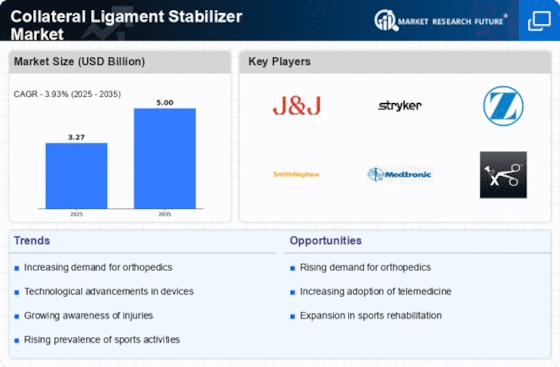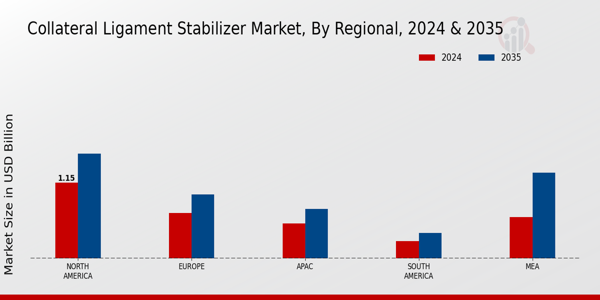Rising Incidence of Sports Injuries
The increasing incidence of sports injuries is a critical factor propelling the Collateral Ligament Stabilizer Market. As more individuals engage in competitive sports, the likelihood of sustaining ligament injuries rises, necessitating the use of stabilizers for effective treatment and prevention. Recent studies indicate that knee injuries, particularly those involving collateral ligaments, account for a substantial percentage of sports-related injuries. This trend is prompting manufacturers to innovate and diversify their product offerings to meet the growing demand. The Collateral Ligament Stabilizer Market is thus positioned for growth, with projections indicating a potential market expansion of 5% annually over the next few years.
Awareness of Preventive Healthcare Measures
The increasing awareness of preventive healthcare measures is significantly influencing the Collateral Ligament Stabilizer Market. As individuals become more health-conscious, there is a growing recognition of the importance of injury prevention, particularly in sports and physical activities. This awareness is driving demand for collateral ligament stabilizers, as they are seen as essential tools for maintaining joint health and preventing injuries. Market trends suggest that educational campaigns and community programs focused on injury prevention are likely to further boost the adoption of these devices. Consequently, the Collateral Ligament Stabilizer Market is expected to witness a steady growth trajectory, with an estimated increase of 4% in market size over the next few years.
Growing Focus on Rehabilitation and Recovery
The emphasis on rehabilitation and recovery in the healthcare sector is driving the Collateral Ligament Stabilizer Market. Healthcare professionals increasingly recognize the importance of using stabilizers as part of comprehensive rehabilitation programs for patients recovering from ligament injuries. This focus on recovery not only aids in faster healing but also reduces the risk of re-injury, which is a common concern among patients. Market analysis suggests that the rehabilitation segment of the Collateral Ligament Stabilizer Market is likely to expand significantly, with an anticipated growth rate of around 6% annually as more healthcare facilities adopt these devices as standard practice.
Increased Participation in Sports and Physical Activities
The rising trend of participation in sports and physical activities is a significant driver for the Collateral Ligament Stabilizer Market. As more individuals engage in high-impact sports, the incidence of ligament injuries has concurrently increased, leading to a heightened demand for stabilizers. This trend is particularly evident among younger demographics, where sports participation rates have surged. According to recent statistics, the market for sports-related injury prevention products, including collateral ligament stabilizers, is expected to reach a valuation of over 1 billion dollars by 2026. This growth underscores the necessity for effective injury management solutions within the Collateral Ligament Stabilizer Market.
Technological Innovations in Collateral Ligament Stabilizers
The Collateral Ligament Stabilizer Market is experiencing a surge in technological innovations that enhance the efficacy and usability of these devices. Advanced materials, such as lightweight composites and smart textiles, are being integrated into stabilizers, providing improved support and comfort for users. Furthermore, the incorporation of biomechanical engineering principles allows for better alignment and stabilization of the ligaments, which is crucial for athletes and individuals recovering from injuries. Market data indicates that the demand for technologically advanced stabilizers is projected to grow at a compound annual growth rate of approximately 7% over the next five years, reflecting a shift towards more sophisticated solutions in the Collateral Ligament Stabilizer Market.


















Leave a Comment